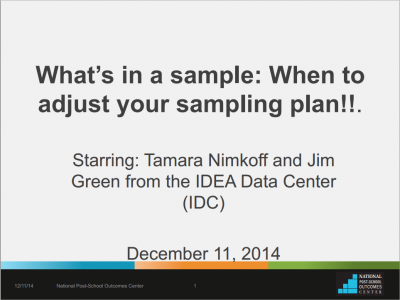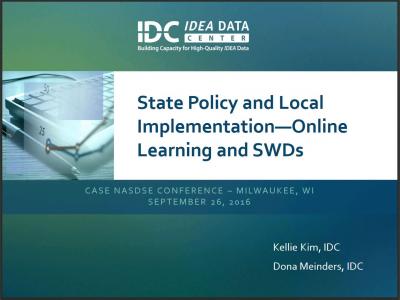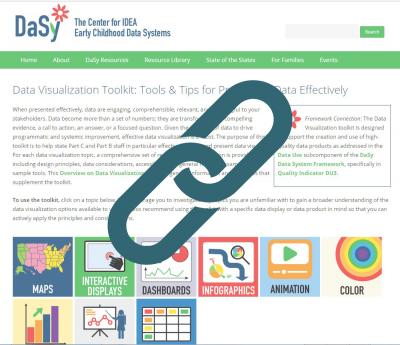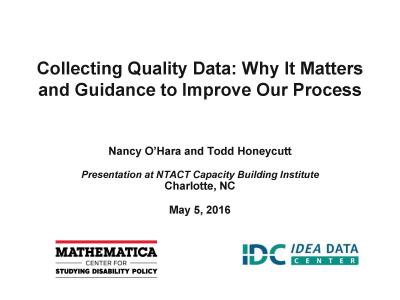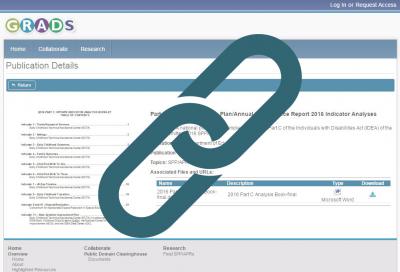Archived Resources
The Resource Library houses tools and products that were developed by IDC, developed with its collaborators, or submitted by IDC stakeholders. Search and filtering tools are available to help users navigate through the library.
Archived Resources 57 - 63 of 222
Format: Presentations
What's in a sample: When to adjust your sampling plan!!IDC staff joined the NPSO Community of Practice call December 11 to present examples for states to consider that would constitute a change of their sampling plans. Staff explained how states can get TA on sampling from IDC. The call also offered a refresher on the NPSO sampling and response calculators that states can use for their SPP/APR work.
Format: Presentations
Supporting and Reporting CEISPanel presenters from IDC, NCSI, and the Wisconsin Department of Public Instruction discussed CEIS including required and voluntary implementation as well as activities that may be provided using these funds. Presenters also reviewed IDC's Navigating CEIS White Paper and FAQ documents and discussed data and fiscal requirements for LEAs implementing this program. Additionally, Rachel Zellmer described how Wisconsin administers CEIS and works with its LEAs to ensure appropriate services are provided that maximize impact while addressing, if appropriate, why the LEA was identified.
Format: Presentations
State Policy and Local Implementation—Online Learning and SWDsFindings from IDC’s white paper and interviews of select states revealed that LEAs are responsible for determining LRE and implementation and monitoring of IEPs in online environments. Presentation of findings were followed by a panel discussion of states and LEAs to discuss key problems of practice and needs for resources that IDC can develop to support greater understanding of implications of online learning for SWDs and the relationship to high-quality data.
Format: Toolkits and Templates
Data Visualization Toolkit: Tools & Tips for Presenting Data EffectivelyThe purpose of the toolkit is to help state Part C and Part B staff effectively create and use engaging data displays. For each data visualization topic, the toolkit presents a comprehensive set of resources and information, including design principles, data considerations, accessibility tips, general how-to’s, examples, and sample tools. DaSy and NCSI partnered to create the toolkit.
Format: Toolkits and Templates
Part C IDEA Data Processes ToolkitUsing the Part C IDEA Data Processes Toolkit to document data processes for all 616 and 618 data collections will establish a well-managed process for data collection, validation, and submission. In collaboration with IDC State Liaisons, states can use the toolkit to create and maintain a culture of high-quality data and establish and support consistent practices that produce valid and reliable data, while building the capacity of state staff. The toolkit contains an overview of the toolkit, Data Collection Protocols, SPP/APR Indicator Protocols, a State Landscape Protocol, a Local EI Program Determinations Protocol, a Data Collections Calendar, and additional resources that provide a structure for documenting data processes. The Data Collection Protocols are in Word, and states can tailor them meet their states' specific documentation needs.
Format: Presentations
Collecting Quality Data: Why It Matters and Guidance to Improve Our ProcessThis presentation provided information that would allow participants to increase their knowledge of what constitutes high-quality data, how to improve processes for collecting high-quality data, and the use of high-quality data for measuring program effectiveness.
Format: Recordings
Part C State Performance Plan/Annual Performance Report 2016 Indicator AnalysesThe Part C State Performance Plan/Annual Performance Report 2016 Indicator Analyses presents a national picture of the implementation of IDEA based on a review of information 56 states and jurisdictions reported in their FFY 2014 APRs and amended SPPs that they subsubmitted to OSEP in spring of 2016.

